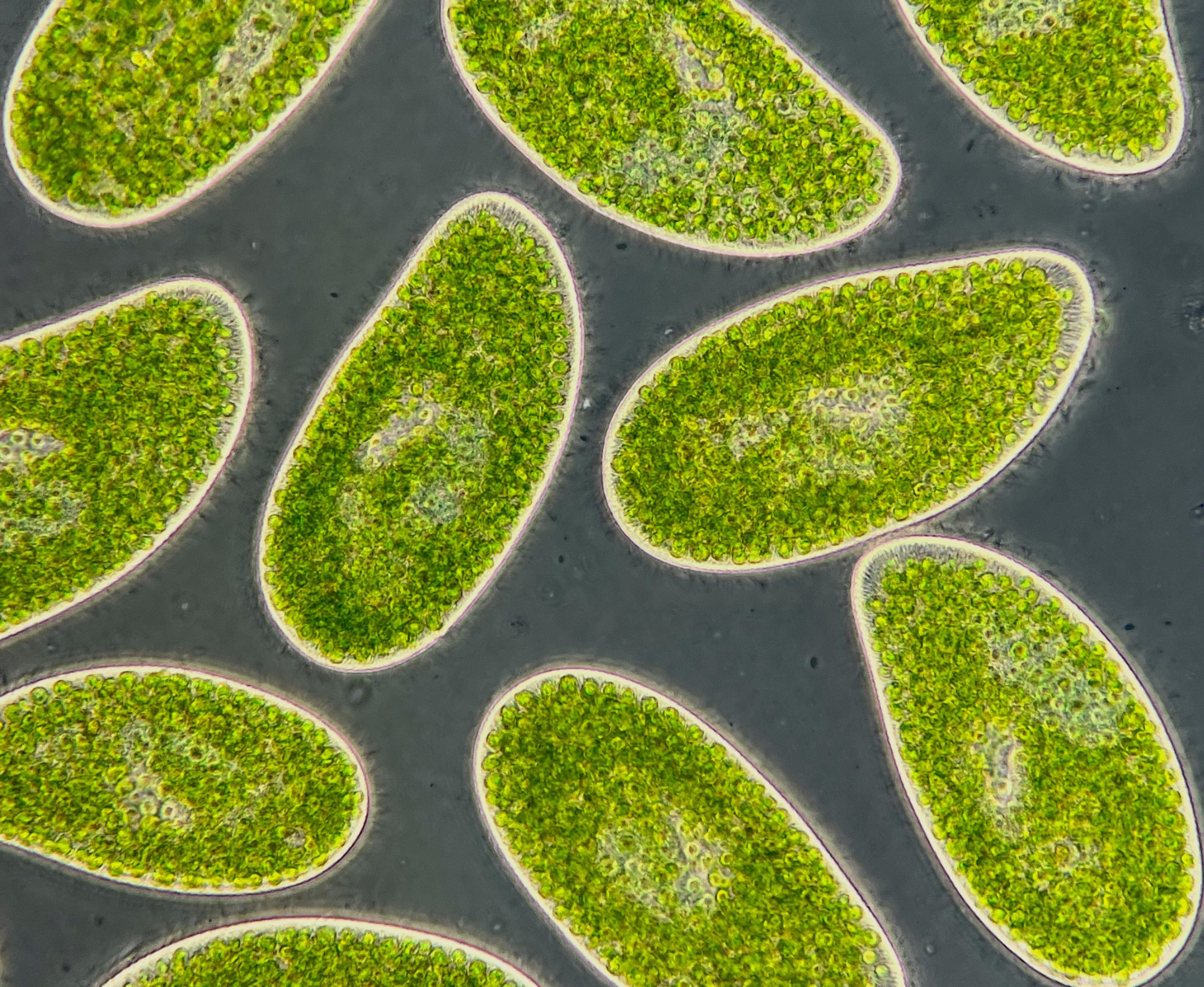
A világ tavaiban és folyóiban megtalálhatók, ilyen egysejtű lények Paramecium bursaria Képes enni és fotoszintetizálni is. Az ehhez hasonló mikrobák kettős szerepet játszanak az éghajlatváltozásban: szén-dioxidot – a hőcsapdába ejtő üvegházhatású gázt, amely a felmelegedés elsődleges mozgatórugója – felszabadítják vagy elnyelik, attól függően, hogy állati vagy növényi életmódot folytatnak. Köszönetnyilvánítás: Daniel J Wiczynski, Duke Egyetem
A növekvő hőszint az óceáni planktont és más egysejtű szervezeteket a szén-dioxid-küszöb felé tolhatja, ami súlyosbíthatja a globális felmelegedést. A legújabb tanulmányok azonban azt sugallják, hogy lehetséges lehet a korai figyelmeztető jelek azonosítása, mielőtt ezek a szervezetek elérnék ezt a kritikus pontot.
Egy széles körben elterjedt, de gyakran figyelmen kívül hagyott mikrobák osztályán kutató tudósok egy csoportja felfedezett egy éghajlati visszacsatolási hurkot, amely fokozhatja a globális felmelegedést. Ennek a megállapításnak azonban van egy jó oldala is: ez egy korai figyelmeztető jelzés is lehet.
A Duke Egyetem és a Santa Barbarai Kaliforniai Egyetem kutatói számítógépes szimulációk segítségével kimutatták, hogy a globális óceáni planktonok túlnyomó többsége, valamint sok tavakban, tőzeges területeken és más ökoszisztémákban élő egysejtű élőlények a kibillenéshez érhetnek. pont. Itt a szén-dioxid elnyelése helyett az ellenkezőjét kezdik el csinálni. Ez a változás annak az eredménye, ahogyan az anyagcseréd reagál a felmelegedésre.
Mivel a szén-dioxid üvegházhatású gáz, ez viszont megemelheti a hőmérsékletet – ez egy pozitív visszacsatolási hurok, amely gyors változáshoz vezethet, ahol a kis mennyiségű felmelegedés nagy hatással van.
Ám ha gondosan figyelemmel kísérjük bőségüket, még azelőtt megelőlegezhetjük a fordulópontot, hogy az elérkezne – számoltak be a kutatók a Nature folyóiratban június 1-jén megjelent tanulmányukból. funkcionális ökológia.
Az új tanulmányban a kutatók a mikroorganizmusok egy csoportjára, az úgynevezett mixotrófokra összpontosítottak, amelyeket azért neveztek el, mert kétféle anyagcsere-módot kevernek össze: a körülményektől függően képesek fotoszintetizálni, mint egy növény, vagy vadászni élelmiszerre, mint egy állat.
„Olyanok[{” attribute=””>Venus fly traps of the microbial world,” said first author Daniel Wieczynski, a postdoctoral associate at Duke.
During photosynthesis, they soak up carbon dioxide, a heat-trapping greenhouse gas. And when they eat, they release carbon dioxide. These versatile organisms aren’t considered in most models of global warming, yet they play an important role in regulating climate, said senior author Jean P. Gibert of Duke.
Most of the plankton in the ocean — things like diatoms, dinoflagellates — are mixotrophs. They’re also common in lakes, peatlands, in damp soils, and beneath fallen leaves.
“If you were to go to the nearest pond or lake and scoop a cup of water and put it under a microscope, you’d likely find thousands or even millions of mixotrophic microbes swimming around,” Wieczynski said.
“Because mixotrophs can both capture and emit carbon dioxide, they’re like ‘switches’ that could either help reduce climate change or make it worse,” said co-author Holly Moeller, an assistant professor at the University of California, Santa Barbara.
To understand how these impacts might scale up, the researchers developed a mathematical model to predict how mixotrophs might shift between different modes of metabolism as the climate continues to warm.
The researchers ran their models using a 4-degree span of temperatures, from 19 to 23 degrees Celsius (66-73 degrees Fahrenheit). Global temperatures are likely to surge 1.5 degrees Celsius above pre-industrial levels within the next five years, and are on pace to breach 2 to 4 degrees before the end of this century.
The analysis showed that the warmer it gets, the more mixotrophs rely on eating food rather than making their own via photosynthesis. As they do, they shift the balance between carbon in and carbon out.
The models suggest that, eventually, we could see these microbes reach a tipping point — a threshold beyond which they suddenly flip from carbon sink to carbon source, having a net warming effect instead of a cooling one.
This tipping point is hard to undo. Once they cross that threshold, it would take significant cooling — more than one degree Celsius — to restore their cooling effects, the findings suggest.
But it’s not all bad news, the researchers said. Their results also suggest that it may be possible to spot these shifts in advance, if we watch out for changes in mixotroph abundance over time.
“Right before a tipping point, their abundances suddenly start to fluctuate wildly,” Wieczynski said. “If you went out in nature and you saw a sudden change from relatively steady abundances to rapid fluctuations, you would know it’s coming.”
Whether the early warning signal is detectable, however, may depend on another key factor revealed by the study: nutrient pollution.
Discharges from wastewater treatment facilities and runoff from farms and lawns laced with chemical fertilizers and animal waste can send nutrients like nitrate and phosphate into lakes and streams and coastal waters.
When Wieczynski and his colleagues included higher amounts of such nutrients in their models, they found that the range of temperatures over which the telltale fluctuations occur starts to shrink until eventually the signal disappears and the tipping point arrives with no apparent warning.
The predictions of the model still need to be verified with real-world observations, but they “highlight the value of investing in early detection,” Moeller said.
“Tipping points can be short-lived, and thus hard to catch,” Gibert said. “This paper provides us with a search image, something to look out for, and makes those tipping points — as fleeting as they may be — more likely to be found.”
Reference: “Mixotrophic microbes create carbon tipping points under warming” by Daniel J. Wieczynski, Holly V. Moeller and Jean P. Gibert, 31 May 2023, Functional Ecology.
DOI: 10.1111/1365-2435.14350
The study was funded by the Simons Foundation, the National Science Foundation, and the U.S. Department of Energy.

„Utazási specialista. Tipikus közösségi média tudós. Az állatok barátja mindenhol. Szabadúszó zombinindzsa. Twitter-barát.”





More Stories
A Plútó magját valószínűleg egy ősi ütközés hozta létre
Ez az aktív vulkán az Antarktiszon valódi aranyport lövell ki
Az „ördögi üstökös” 12P/Pons-Brooks a Nap felé tart. Túléled?